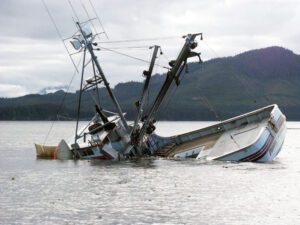
As the old trope goes, wise men learn from their own mistakes, but wiser men learn from the mistakes of others. It’s also a lot less expensive.
So, how can vessel operators learn from their own mistakes without injuring anyone and incurring the costs? Wouldn’t it be more effective to learn from the near misses/close calls of other fishermen in similar regions or fisheries in order to lessen injuries on their own vessels?
AMSEA is looking for fishermen who want to help evaluate an anonymous, cost-free, near-miss reporting system on their own vessel.
AMSEA is working with NIOSH (the National Institute for Occupational Safety and Health) and the ABS Group to develop a type of reporting system in which operators can share examples of close calls that have occurred on their own vessels with other operators without naming the vessel, company or crew.
A study in close-call reporting in health care demonstrated that when people feel secure about sharing catastrophes that were narrowly avoided, the likelihood of reporting such incidents increases and more prevention methods are practiced.
A near miss should not be seen as a failure as much as an opportunity. If reported, it is less likely to be repeated, while becoming a successful learning opportunity.
Per square foot, a fishing vessel is one of the most crowded workplaces, with hazards due to fishing gear, machinery, electrical wiring and components, hydraulics, fuels, foul weather, stability, sharp objects, open hatches, slippery surfaces, poisonous gases, limited working space, hazards from the fish themselves, and more.
Even its deck is in constant motion. In addition, outside the watertight envelope of the vessel is an unforgiving ocean. The risk of getting injured is inherently high and help is far away. It’s a high-risk job with high-risk rewards.
Fortunately, most risks if identified early can be managed and there are a lot more near-miss events than injuries. There are also a lot more injuries than fatalities. However, that initial near miss is a warning; if repeated by someone else, the situation may end in an injury or fatality. Events, such as slipping on a ladder due to the lack of non-skid on the rung, are usually a survivable, non-injury event if there is a three-point hold on the ladder.
But the slip is a warning—and an opportunity to lessen the risk to someone else—if the near miss is recognized and reported. The risk is reduced in this example by applying non-skid material to the ladder rungs. If a near miss occurs, and no action is taken to reduce the risk, that in and of itself is a missed opportunity.
How is it possible to know all of the more common and not so common risks on specific types of fishing vessels without someone getting hurt first or having been informed of the risk first? Leaving crew to just depend on “common sense” is not an effective risk-reduction plan.
Reporting near misses is important on any vessel and is also a part of any quality Safety Management System (SMS) program. It allows companies or individual vessels to keep ahead of risks by identifying other near misses and having an opportunity to mitigate the issues on their own vessels, preventing more close calls or injuries.
For more information about this program or to participate, contact AMSEA at director@amsea.org or (907) 747-1717.
The Alaska Marine Safety Education Association (AMSEA) has a mission is to reduce injury and death in the marine and freshwater environment through education and training provided by a network of marine safety instructors. The Sitka, Alaska-based organization has been offering marine safety training to commercial fishermen and thousands of other mariners since 1985. Jerry Dzugan is the Executive Director of AMSEA.
More information on marine safety topics can be found at www.amsea.org
